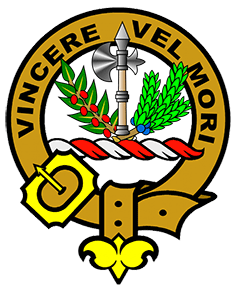Clan MacLaine of Lochbuie
MacLaine of Lochbuie Crest: A battle-axe, in pale, crossed by a branch of laurel and cyprus, in saltier, all Proper.
MacLaine of Lochbuie Motto: Vincere Vel Mori (To conquer or die).
MacLaine of Lochbuie History: The MacLaines of Lochbuie are descended from Eachin Reganach, also known as Hector the Stern. He was the older brother of Lachlan Lubanach, also known as Lachlan the Wily, forebear of the Macleans of Duart. The brothers lived in the 14th century during the reign of Robert II.
Hector was granted lands on the West Coast island of Mull by John, 1st Lord of the Isles, and located his headquarters at the head of Loch Buie, a defensive spot formerly occupied by Clan MacFadzean. In the years that followed, clan possessions included the islands of Scarba, Jura and part of Tiree, and mainland territory on Morvern and in Locheil.
Towards the end of the 15th century, Ewan, the only son of John Og, 5th Chief of Lochbuie, also known as Iain the Toothless, rebelled against his father and a battle took place between their followers, involving their kinsmen, the Macleans of Duart.
Ewan was mortally wounded and, fleeing from the battlefield on horseback, cried out, "I will return yet!" Since that time, many MacLaine's on their deathbeds have heard the sound of hoof-beats from a galloping horse as their end approaches.
After his son's defeat and death, John Og was taken hostage by the Macleans of Duart and imprisoned on a small island with only an elderly female retainer to keep him company. Much to everyone's amazement, John Og fathered a second son by her. This boy was named Murdoch 'the Short', and sent to Glencannel to be raised under the protection of Clan MacGillivray. Having come of age, he returned to Lochbuie to claim, by force of arms, the estate and castle of his now dead father, and was officially legitimised in 1538.
John Mor, 7th Chief, became an expert swordsman and was called upon to fight a dual with an Italian Master-at-Arms in front of James VI. He accepted the challenge, and the Italian was killed in the confrontation. John Mor's son, Hector, was the first to employ the spelling “MacLaine”.
Murdoch Mor, 10th Chief, fought alongside the Marquis of Montrose at the Battle of Kilsyth in 1645 and, as a consequence, his lands were forfeited and not restored until 1661. The 12th Chief was a Jacobite supporter and fought at the Battle of Killiecrankie. The MacLaines did not, however, take part in the 1745 Uprising and, unlike the Macleans of Duart, held onto their estate.
Murdoch, 23rd Chief of Lochbuie was a founder of the Argyllshire Gathering in 1871, an annual event held at Oban in August and which continues to attract a large attendance. Unfortunately, family debts caught up with the 24th Chief, and the Lochbuie estates were lost after the First World War.
The Chiefship of Clan Maclean was traditionally settled by tanistry, and Duart is recognised as Chief of Clan Maclean, although Eachin Reganach was, in fact, the older brother of Lachlan Lubanach. Charles, son of Eachin, was ancestor of the Macleans of Glen Urquhart and Dochgarroch, which became a Sept of Clan Chattan. Over the 18th, 19th and early 20th centuries, large numbers of MacLaines left Scotland for Ulster, America, Canada and New Zealand.
Surname distribution in Scotland: The MacLaine surname is most commonly found in Argyllshire, Renfrewshire, Dumfries and Galloway (Dumfriesshire, Kirkcudbrightshire and Wigtownshire) and the Borders (Berwickshire, Peeblesshire, Roxburghshire and Selkirkshire).
Places of Interest: Castle Moy, Loch Buie, Isle of Mull. Ruined fortress of the MacLaines of Loch Buie. It was their headquarters for 500 years.
Associated family names (Septs): Beaton, Black, Cormack, Cormick, Fadden, Lane, Laine, Lain, Layne, Lean, MacAvoy, MacBay, MacCormack, MacCormick, MacEvoy, MacFadyen, MacFadden, MacFadzean, MacFetridge, MacGillivray, MacIlvora, MacLayne, MacPhadon, MacVay, Patton, Patten, Paton.

